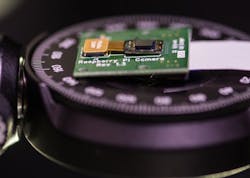Rice University coded-mask camera is almost as thin as its sensor
In a coded-mask camera, a mask with a gridlike designed transmission profile is placed in front of the sensor array and a computer algorithm used to decode the information to produce an image. Researchers at Rice University (Houston, TX) and Carnegie Mellon University (Pittsburgh, PA) have invented an improved version of a coded-mask camera in which the mask can be placed very close to the sensor, making the entire package very thin (see video below).1 Called the FlatCam, the device has been created in two forms—one operating at visible wavelengths (producing color images) and one in the shortwave IR (SWIR). Both cameras use commercial sensor arrays.
While the FlatCam can be thought of hand-wavingly as an ultrasophisticated form of pinhole camera with many pinholes, in reality it is even better than that: to create sharp images, a pinhole camera needs to work at a very low light throughput (f/22), while the FlatCam can operate at a high throughput (f/2.54).
FlatCams can be fabricated like microchips, with the precision, speed and the associated reduction in costs, says Ashok Veeraraghavan, one of the Rice researchers. Without the need for lenses, he adds, the most recent prototype is thinner than a dime. In addition, although it's called the FlatCam, the device could even be made with a curved and/or flexible sensor, being mounted on a credit card, for example. Rice’s hand-built prototypes use off-the-shelf sensors and produce 512-by-512 images (for the visible-light version) in seconds, but the researchers expect that resolution will improve as more advanced manufacturing techniques and reconstruction algorithms are developed.
The FlatCam team is working with the Rice lab of Jacob Robinson to develop next-generation directly fabricated devices. The research team will deliver a talk about its work at the Extreme Imaging Workshop Dec. 17 in Santiago, Chile.
Source: http://news.rice.edu/2015/11/23/no-lens-no-problem-for-flatcam/
REFERENCE:
1. M. Salman Asif et al., arXiv:1509.00116 (2015).
About the Author
John Wallace
Senior Technical Editor (1998-2022)
John Wallace was with Laser Focus World for nearly 25 years, retiring in late June 2022. He obtained a bachelor's degree in mechanical engineering and physics at Rutgers University and a master's in optical engineering at the University of Rochester. Before becoming an editor, John worked as an engineer at RCA, Exxon, Eastman Kodak, and GCA Corporation.

